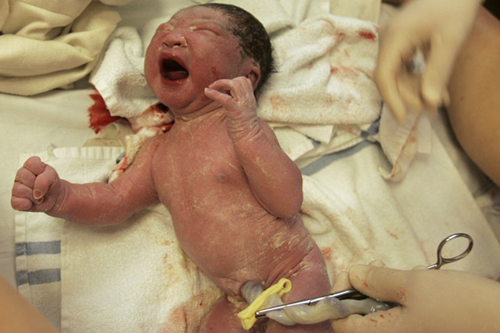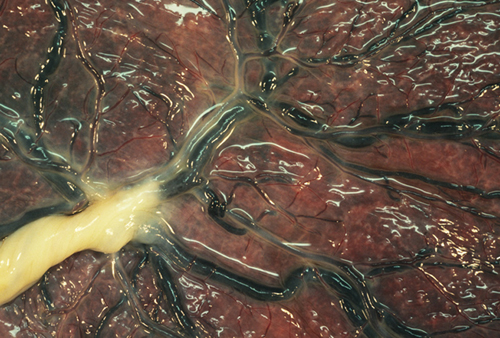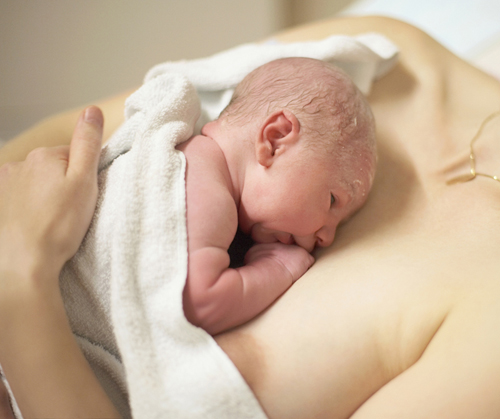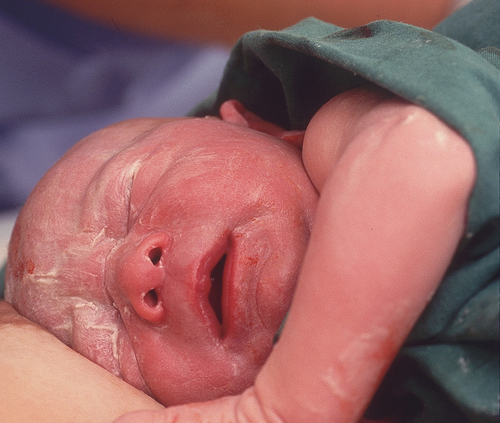After your Baby is Born
Shortly after your baby’s birth, the cord will be cut and your uterus will start to contract again to deliver the placenta.
The third stage
This is from the birth of
your baby until the delivery of the membranes (the amniotic bag that
surrounded your baby) and placenta. The placenta can be actively managed
with the help of drugs or delivered without drugs, known as passive
management or a physiological third stage. Your doctor will discuss
these options with you before labor.
Cutting the cord
Once your baby has been
delivered, it may be left for two to three minutes before it is cut.
Allowing the cord to pulsate for a few minutes means your baby receives
more blood from the placenta, which boosts his or her oxygen supply and
blood volume. The cord will be clamped in two places, about 1 cm and 4
cm from the baby’s belly, and is cut with scissors between the clamps.
The umbilical cord will be clamped and cut, a few minutes after the birth, severing the link between your baby and the placenta.

Delivery of the placenta
How your placenta is
delivered depends on your doctor. Many wait for it to happen naturally,
but others offer an intramuscular (IM) injection of an oxytoxic drug in
your thigh to make the uterus contract so that you can deliver the
placenta and membranes quickly. Helping the uterus contract in this way
reduces the risk of heavy bleeding occurring during the third stage,
known as a postpartum hemorrhage (see Postpartum hemorrhage)
and speeds up the delivery of the placenta, which can happen within 5
to 15 minutes after the birth of the baby. The risk of a postpartum
hemorrhage occurring is the reason many units advise an active delivery.
If you have a fibroid, active delivery will be advised because there is
a heavy risk of bleeding.
Your doctor will place one
of her hands just above your pubic bone to prevent the uterus from
being pulled downward when she pulls on the cord. With her other hand,
she will then apply gentle traction to the cord to help deliver the
membranes and placenta. This is known as “controlled cord traction”
(CCT).
The disc-shaped placenta, weighing around 1 lb 2 oz (500 g), has a network of blood vessels surrounding the umbilical cord in its center.

Delivering the placenta naturally
If you decide to
deliver the placenta without drugs, known as a physiological third
stage, this can take up to an hour. Your doctor will encourage you to
bear down and you may find squatting helps. The doctor will check the
placenta to ensure it’s complete and that none of it remains in the
uterus, which can cause a postpartum hemorrhage.
How you feel after the birth
After the huge effort of
giving birth, it’s common to have a physical reaction. Many women
experience uncontrollable shaking or shivering, and some feel nauseous
and may even vomit. In addition to your physical reaction, you are also
likely to be feeling overwhelmed and emotional. Once you and your baby
have been given the all clear, you should be given some quiet time alone
to get to know each other.
Skin-to-skin contact
with your newborn baby will help keep her warm—newborns don’t have very
good temperature control—and will also help the two of you start
bonding.

First checkups
Apgar score
At 1, 5, and 10 minutes,
your baby’s breathing, pulse, movements, skin color, and responses are
assessed. In South Asian and black babies, the color of the mouth, palms
of the hands, and soles of the feet are checked. Each is given a score
between 0 and 2, called the Apgar score. A total of 7 or more at 1
minute is normal; under 7 means help is needed.
Table
| Apgar score | 2 | 1 | 0 |
|---|
|
Skin color
| Pink all over | Body pink; extremities blue | Pale/blue all over |
|
Breathing
| Regular strong cry | Irregular, weak cry | Absent |
|
Pulse/heart rate
| Greater than 100 bpm | Less than 100 bpm | Absent |
|
Movements/muscle tone
| Active | Moderate activity | Limp |
|
Reflexes after given certain stimuli
| Crying or grimacing strongly | Moderate reaction or grimace | No response |
Postpartum hemorrhage
A postpartum hemorrhage
describes the loss of up to 1 pint (500 ml) of blood after the
delivery. This is often associated with a retained placenta, when the
placenta remains in the uterus for a prolonged period of time, which is
most likely to occur during a natural delivery of the placenta. It can
also occur after an assisted forceps delivery; after a prolonged labor;
or following a cesarean. Improvements in the treatment of this condition
with antibiotics and blood transfusions has meant that the incidence of
complications following a hemorrhage has fallen considerably over the
years.
Your baby’s appearance
Newborn babies are usually surprisingly unattractive.
Fortunately, as parents, we usually think they are beautiful. Newborns
are covered in a waxy substance called vernix, together with amniotic
fluid and blood from the birth canal. Babies who have passed meconium
before the delivery may also have brown stained skin and nails.
In addition, newborn
babies often have a molded, elongated head, with a swollen area on top
known as a “caput,” which is due to the pressure on the baby’s head as
it passes through the birth canal. Also, the nose may be squished to one
side and the eyes may be swollen. Sometimes the genitals are swollen
too. Rest assured that all of these features are temporary and within 24
hours or so the molding will work itself out and your baby will begin
to look more like the baby you were expecting to meet.
Many babies are born with
birthmarks that are referred to as “stork marks.” These are red
birthmarks on the eyelids and at the nape of the neck, which fade in
time.
Your newborn baby may have a squashed appearance, but this will smooth out within a day or two.
